-
Faulkes Telescope Project Privacy Policy
15 years of FTP – Highlights from 2017!
This month we are celebrating 15 years of the Faulkes Telescope Project – over the course of the next couple of weeks we will showcase some of the highlights from these past 15 years, hear from schools who have used the telescopes and meet the team who spend their time bringing the Universe to your classroom!
Today we are looking at the highlights from 2017…
———————————————————————————————————-
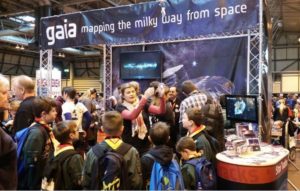
FTP Team at the Big Bang fair
Last week the FT team were at the Big Bang Fair with the Gaia Alerts team from the University of Cambridge. Schools from all over the UK came along to the event to learn about all the science careers available to them.
The Faulkes team were there to show pupils how they can get involved in using our telescopes to observe all kinds of wonders in the Universe. In paticular, pupils and teachers were offered a chance to “Adopt a Supernova” and become involved in the Gaia Alerts project. Using the telescope network, students can track a new supernova as it explodes and fades over time.
The audience were also among some of the first to experience Mat Allen’s newly developed augmented reality app that allows you to hold a planet in your hand! Find out more and access the app here.
FTP travels
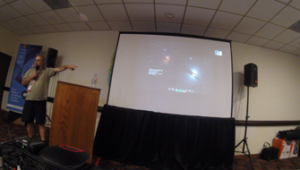
Fraser Lewis at the RTSE in San Diego
This year, Fraser and Sophie from the FT team were in San Diego showcasing some of the work schools have been doing with the telescope network.
They attended the Robotic Telescopes, Student Research and Education (RTSRE) conference and were invited to talk about some of the work they have been doing.
The conference focused on robotic telescopes around the world and how they have been used by students and schools. Many local students also attended to show some of their work, discuss the success they’ve had with the telescopes and even the science publications they have produced.
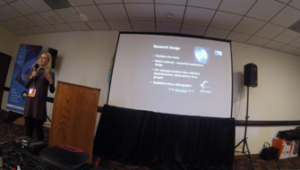
Sophie Bartlett speaking at the RTSE conference in San Diego
Fraser and Sophie talked about some of the previous work schools involved with FT have produced, various collaborations and also the opportunities that we provide to students in terms of observation and data analysis projects.
The Faulkes Telescope Project generated a lot of interest and many schools in America were eager to get involved and work with other schools in the UK and Europe.
School’s news with FTP
A new school teacher member of the Faulkes Telescope Project this year, Paul Breiteinstein from Germany, has been working hard with his students, spotting asteroids. Below he tells us all about their new hobby!
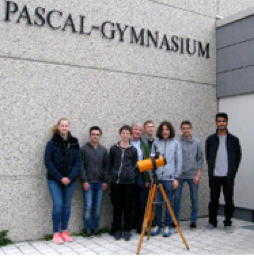
Students at the Pascal-Gymnasium in Munster, Germany
Since 2012 the Pascal-Gymnasium in Münster (Germany) has been running the AiM project. AiM stands for “Astronomy and internet in Münster”. Our real aim is using the modern possibilities provided by the Internet to make astronomical and astrophysical discoveries.
At our school we only have the possibility using an old 8 inch Celestron reflector, a small Coronado solar refractor and a little Newtonian telescope. But the biggest problem is
the high humidity, clouds and light pollution in our home town. Also in summer we have short nights, and in winter cold nights. So we have looked for better options.
In co-operation with the University of Göttingen (Germany) we have already worked with MONET (MOnitoring NEtwork of Telescopes) – two 1.2m Ritchey-Chretien-telescopes, one at McDonald Observatory in Texas/US and the other at the South African Astronomical Observatory in Sutherland (South Africa). Later we used the 0.4m Bradford Robotic Telescope on Mt. Teide (Tenerife) to observe the Mira-type variable NSV 24959 (the “Goldilocks Variable” – see: https://www.aavso.org/vsx/index.php?view=detail.top&oid=63394).
Since the beginning of 2017 the House of Astronomy in Heidelberg (Germany) gave us the chance of using the Faulkes Telescopes, and we were very surprised about the good and solid support we received.
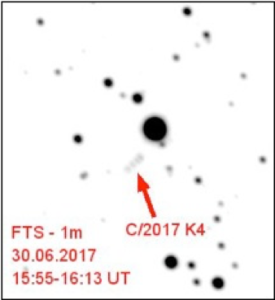
One of the new comets confirmed by German teacher Paul Breitenstein and his students
We got hooked on tracking asteroids by different campaigns with the IASC (International Astronomical Search Collaboration), an educational outreach program for high schools and colleges working with the Pan-STARRS telescope on Mt. Haleakala (Hawaii). So the idea of our own asteroid tracking program was born, and we are now involved in the discoveries of the NEOs (Near-Earth-Object) 2017FL101, 2017HB1 and 2017KR34 by confirmation, as well as in the re-discovery of 2009HS9. Furthermore we confirmed the newly discovered comets P/2017K3, C/2017K4 and C/2017M5 (see: http://pascal.nw.lo-net2.de/aim3/.ws_gen/?10).
One of our main projects is the tracking of comets P/2017K3 and C/2017K4, as well as asteroid 2017KR34, until the end of this year. These NEOs are moving relatively slowly
and parallel to the Earth.
The absolute highlight would be our own discovery of an unknown asteroid or comet. We are out of luck until now, but we are confident.
Real-time observing returns!
Towards the end of 2017, the team at the Faulkes Telescope Project were excited to announce that we would be returning to real-time observing with the LCO telescopes.
Using an interface developed exclusively for us by the team at LCO, we sent out requests to schools to test the new interface and try out the ‘new’ mode of observing.
One group which jumped onboard with using the new interface was students in the 7th grade (11-12 yr olds) at Adolfo Portela High School (Agueda, Portugal), who used the real-time observing mode to study the Universe from their classroom. Below is a report, written by their teacher Alvaro Folhas, on how this observing went:
“Students of teacher Álvaro Folhas had the opportunity to explore the sky of the Southern Hemisphere during their Physics and Chemistry class.
They realized there are astronomical objects characteristic of each hemisphere, and they understood better the importance of using R.A. / Dec coordinates to point to the desired objects. In addition to the magnificent experience that it was felt that this equipment was being controlled by us, thousands of miles away, they got the notion that the brightness of each astronomical objects determined different times of photographic exposure for the capture of light, and that these photographs were all images of the past. It was an unforgettable experience, not just by the issues learned, but also because it reinforce strongly the taste for Science, particularly for Astronomy. ”
Álvaro, the teacher of these classes said ”… this is a fantastic way to rekindle the brightness in the eyes of our students, and develop in them skills and desire to discover science. I want to thank the Faulkes Telescope Project / LCO and its fantastic team, on my personal behalf and on behalf of my students, these opportunities to open windows to the Universe.”
Posted in News
